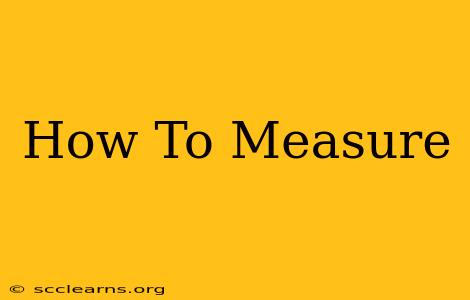Measuring accurately is fundamental to countless aspects of life, from cooking and crafting to scientific research and engineering. This guide explores various measurement techniques and tools, helping you understand how to choose the right method for any task.
Understanding Measurement Units
Before diving into techniques, it's crucial to grasp the different units of measurement. The most common systems are:
-
Metric System (SI Units): This system, based on powers of 10, uses meters (m) for length, kilograms (kg) for mass, seconds (s) for time, and liters (L) for volume. It's the most widely used system globally due to its simplicity and consistency.
-
Imperial System (US Customary Units): Primarily used in the United States, this system employs inches, feet, yards, and miles for length; ounces, pounds, and tons for weight; and gallons, quarts, and pints for volume. Conversion between units can be complex.
-
Other Specialized Units: Depending on the context, you might encounter specialized units like:
- Degrees Celsius (°C) and Fahrenheit (°F): For temperature.
- Hectares (ha) and Acres: For land area.
- Pascals (Pa): For pressure.
Understanding these units and their conversions is key to accurate measurement.
Common Measurement Tools and Techniques
The method you choose depends heavily on what you are measuring:
1. Length Measurement
-
Rulers and Tape Measures: Ideal for measuring straight lines, these tools are readily available and offer varying levels of precision. Choose a ruler or tape measure with appropriate graduations (e.g., millimeters, inches) for your needs.
-
Calipers: Used for precise measurements of internal and external dimensions, particularly in machining and engineering. They provide greater accuracy than rulers for smaller objects.
-
Laser Measuring Tools: These advanced tools use lasers to measure distances accurately over longer ranges, often used in construction and surveying.
2. Mass Measurement
-
Balances (Scales): Balances offer highly precise measurements of mass. Different types exist, from simple beam balances to sophisticated electronic balances used in laboratories.
-
Kitchen Scales: These are suitable for everyday weighing, such as in cooking or baking, offering less precision than laboratory balances.
3. Volume Measurement
-
Graduated Cylinders and Beakers: Used for measuring liquid volumes, these are common in laboratories and offer varying levels of accuracy.
-
Measuring Cups and Spoons: Useful for cooking and baking, these tools provide less precision than graduated cylinders.
-
Displacement Method: This involves submerging an object in a liquid and measuring the volume displaced; it's helpful for irregularly shaped objects.
4. Temperature Measurement
- Thermometers: These come in various forms, including liquid-in-glass thermometers, digital thermometers, and infrared thermometers. The choice depends on the required accuracy and application.
Choosing the Right Tool and Technique
The selection of appropriate measurement tools and techniques depends on the following factors:
-
Accuracy Required: The level of precision needed will determine the tool used (e.g., a ruler for rough measurements, a caliper for precise measurements).
-
Size and Shape of the Object: The size and shape of the object being measured will influence the choice of tool (e.g., a tape measure for long distances, calipers for small objects).
-
Material of the Object: The material might affect the measurement technique (e.g., displacement method for irregularly shaped objects).
-
Environmental Conditions: Temperature and humidity can affect measurements, so appropriate precautions might be necessary.
Error Minimization and Best Practices
To ensure accuracy, consider these best practices:
-
Calibration: Regularly calibrate your tools to ensure accurate readings.
-
Proper Technique: Use the tools correctly; incorrect technique leads to inaccurate results.
-
Multiple Measurements: Take multiple measurements and average them to reduce random errors.
-
Environmental Control: Control environmental factors that could affect your measurements.
-
Unit Consistency: Ensure consistent use of units throughout your measurements and calculations.
By understanding these measurement techniques and adopting best practices, you can significantly improve the accuracy and reliability of your measurements in any field. Accurate measurement is the cornerstone of reliable results, regardless of your specific application.

